Comprehensive Report: Fundamentals of Travel and Tourism Analysis
VerifiedAdded on 2020/03/01
|14
|3588
|163
Report
AI Summary
This report delves into the fundamentals of travel and tourism, tracing its history from the Roman era to the present day. It categorizes tourism into mass and special interest types, analyzing their characteristics. The report examines motivations for tourism, including push and pull factors, and the concept of tourism demand, differentiating between actual, suppressed, and latent demand. It explores various tourist typologies, such as Cohen's and Smith's, and discusses internal and external factors influencing tourist motivations. Furthermore, the report outlines the 'Six A's' of a tourist destination – Attractions, Accessibility, Amenities, Available packages, Activities, and Ancillary services – providing a framework for developing new tourist destinations. The document is contributed by a student to be published on the website Desklib. Desklib is a platform which provides all the necessary AI based study tools for students.

Running head: FUNDAMENTALS OF TRAVEL AND TOURISM
Fundamentals of Travel and Tourism
Name of the Student:
Name of the University:
Author note:
Fundamentals of Travel and Tourism
Name of the Student:
Name of the University:
Author note:
Paraphrase This Document
Need a fresh take? Get an instant paraphrase of this document with our AI Paraphraser
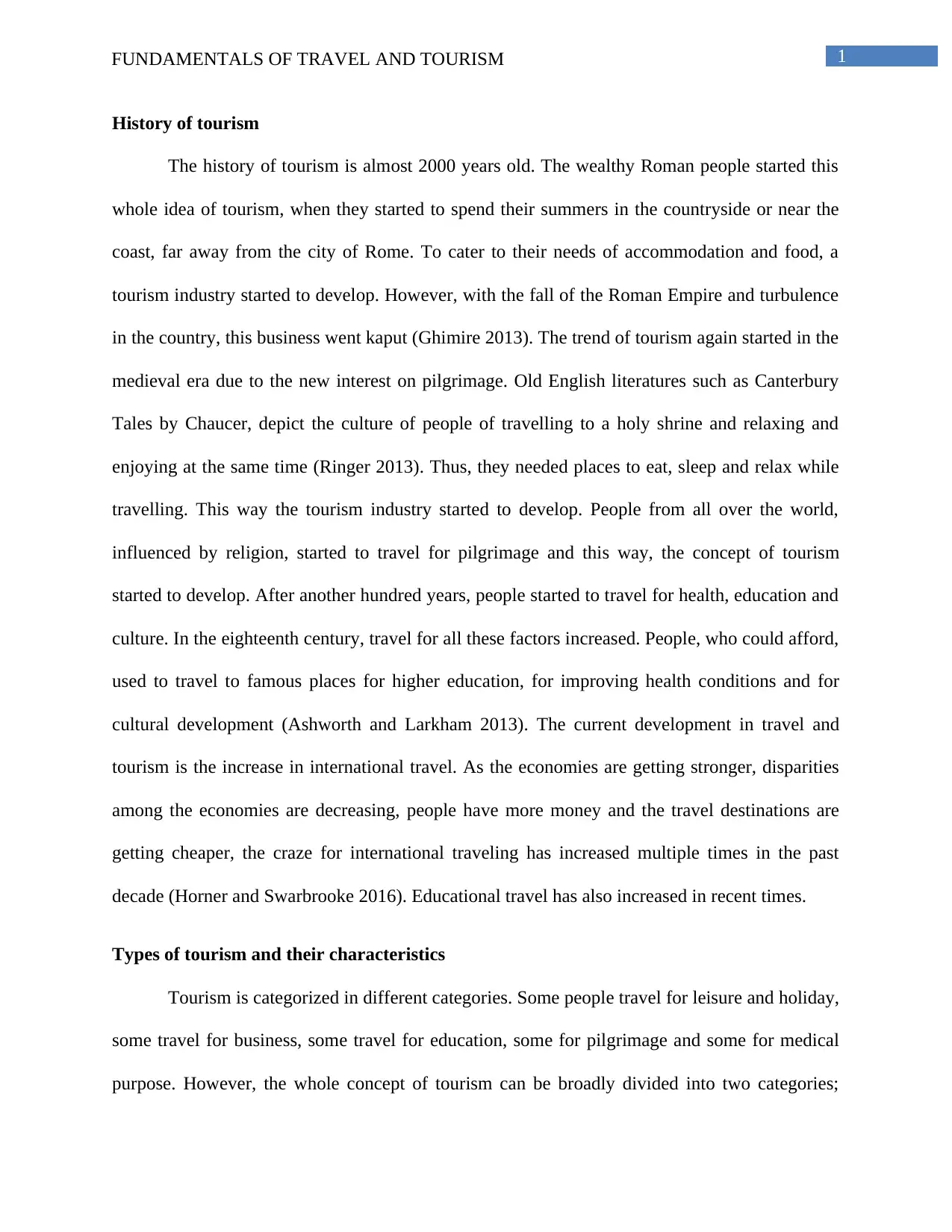
1FUNDAMENTALS OF TRAVEL AND TOURISM
History of tourism
The history of tourism is almost 2000 years old. The wealthy Roman people started this
whole idea of tourism, when they started to spend their summers in the countryside or near the
coast, far away from the city of Rome. To cater to their needs of accommodation and food, a
tourism industry started to develop. However, with the fall of the Roman Empire and turbulence
in the country, this business went kaput (Ghimire 2013). The trend of tourism again started in the
medieval era due to the new interest on pilgrimage. Old English literatures such as Canterbury
Tales by Chaucer, depict the culture of people of travelling to a holy shrine and relaxing and
enjoying at the same time (Ringer 2013). Thus, they needed places to eat, sleep and relax while
travelling. This way the tourism industry started to develop. People from all over the world,
influenced by religion, started to travel for pilgrimage and this way, the concept of tourism
started to develop. After another hundred years, people started to travel for health, education and
culture. In the eighteenth century, travel for all these factors increased. People, who could afford,
used to travel to famous places for higher education, for improving health conditions and for
cultural development (Ashworth and Larkham 2013). The current development in travel and
tourism is the increase in international travel. As the economies are getting stronger, disparities
among the economies are decreasing, people have more money and the travel destinations are
getting cheaper, the craze for international traveling has increased multiple times in the past
decade (Horner and Swarbrooke 2016). Educational travel has also increased in recent times.
Types of tourism and their characteristics
Tourism is categorized in different categories. Some people travel for leisure and holiday,
some travel for business, some travel for education, some for pilgrimage and some for medical
purpose. However, the whole concept of tourism can be broadly divided into two categories;
History of tourism
The history of tourism is almost 2000 years old. The wealthy Roman people started this
whole idea of tourism, when they started to spend their summers in the countryside or near the
coast, far away from the city of Rome. To cater to their needs of accommodation and food, a
tourism industry started to develop. However, with the fall of the Roman Empire and turbulence
in the country, this business went kaput (Ghimire 2013). The trend of tourism again started in the
medieval era due to the new interest on pilgrimage. Old English literatures such as Canterbury
Tales by Chaucer, depict the culture of people of travelling to a holy shrine and relaxing and
enjoying at the same time (Ringer 2013). Thus, they needed places to eat, sleep and relax while
travelling. This way the tourism industry started to develop. People from all over the world,
influenced by religion, started to travel for pilgrimage and this way, the concept of tourism
started to develop. After another hundred years, people started to travel for health, education and
culture. In the eighteenth century, travel for all these factors increased. People, who could afford,
used to travel to famous places for higher education, for improving health conditions and for
cultural development (Ashworth and Larkham 2013). The current development in travel and
tourism is the increase in international travel. As the economies are getting stronger, disparities
among the economies are decreasing, people have more money and the travel destinations are
getting cheaper, the craze for international traveling has increased multiple times in the past
decade (Horner and Swarbrooke 2016). Educational travel has also increased in recent times.
Types of tourism and their characteristics
Tourism is categorized in different categories. Some people travel for leisure and holiday,
some travel for business, some travel for education, some for pilgrimage and some for medical
purpose. However, the whole concept of tourism can be broadly divided into two categories;

2FUNDAMENTALS OF TRAVEL AND TOURISM
mass and special interest tourism (Hall and Page 2014). Mass tourism refers to the tourism
activities organized for the mass. It is usually organized by travel companies for large groups of
people to some specialized travel destinations. Sometimes people also organize group tours for
themselves to a specialized location. This also falls under the category of mass tourism. For
example, guided packaged tours conducted by the travel companies to some abroad cities for few
days, cruise tours, bus tours, theme parks, tourist business district tours, resort towns, all
inclusive resorts etc. (Page 2014).
Special interest tourism refers to the travel interest of people for a specific purpose to
specific locations. In other words, this type of tourism involves individuals or groups of people
who want to travel for a specific purpose and to places related to the purpose. It is also known as
niche tourism. It is opposite to the mass tourism in regards to the objectives. In this type of
tourism, the particular interests, needs and motivation of people are taken care of. The leisure
holidays and recreational experiences can also happen for special interest (Frechtling 2012).
There are many people who would like to travel for a specific purpose, such as, to explore the
historical places or natural wonders, to explore different cuisines, to participate in a cultural
event like Mardi Gras, or just to relax. This can be classified as special interest tourism. It also
includes activity tours such as, hiking, cycling, sailing, etc., educational tours, adventure tours
like mountaineering, tours for pursuing hobbies, like wine tasting, discovery of new places,
social tours such as camping, clubbing, medical tourism and pilgrimage tours.
Over the years, the characteristics of tourism have evolved. People are now more
interested in special interest tourism than for mass tourism. Hence, the niche tourism has become
a focus of the travel companies in the past decade (Peng, Song and Crouch 2014).
mass and special interest tourism (Hall and Page 2014). Mass tourism refers to the tourism
activities organized for the mass. It is usually organized by travel companies for large groups of
people to some specialized travel destinations. Sometimes people also organize group tours for
themselves to a specialized location. This also falls under the category of mass tourism. For
example, guided packaged tours conducted by the travel companies to some abroad cities for few
days, cruise tours, bus tours, theme parks, tourist business district tours, resort towns, all
inclusive resorts etc. (Page 2014).
Special interest tourism refers to the travel interest of people for a specific purpose to
specific locations. In other words, this type of tourism involves individuals or groups of people
who want to travel for a specific purpose and to places related to the purpose. It is also known as
niche tourism. It is opposite to the mass tourism in regards to the objectives. In this type of
tourism, the particular interests, needs and motivation of people are taken care of. The leisure
holidays and recreational experiences can also happen for special interest (Frechtling 2012).
There are many people who would like to travel for a specific purpose, such as, to explore the
historical places or natural wonders, to explore different cuisines, to participate in a cultural
event like Mardi Gras, or just to relax. This can be classified as special interest tourism. It also
includes activity tours such as, hiking, cycling, sailing, etc., educational tours, adventure tours
like mountaineering, tours for pursuing hobbies, like wine tasting, discovery of new places,
social tours such as camping, clubbing, medical tourism and pilgrimage tours.
Over the years, the characteristics of tourism have evolved. People are now more
interested in special interest tourism than for mass tourism. Hence, the niche tourism has become
a focus of the travel companies in the past decade (Peng, Song and Crouch 2014).
⊘ This is a preview!⊘
Do you want full access?
Subscribe today to unlock all pages.

Trusted by 1+ million students worldwide
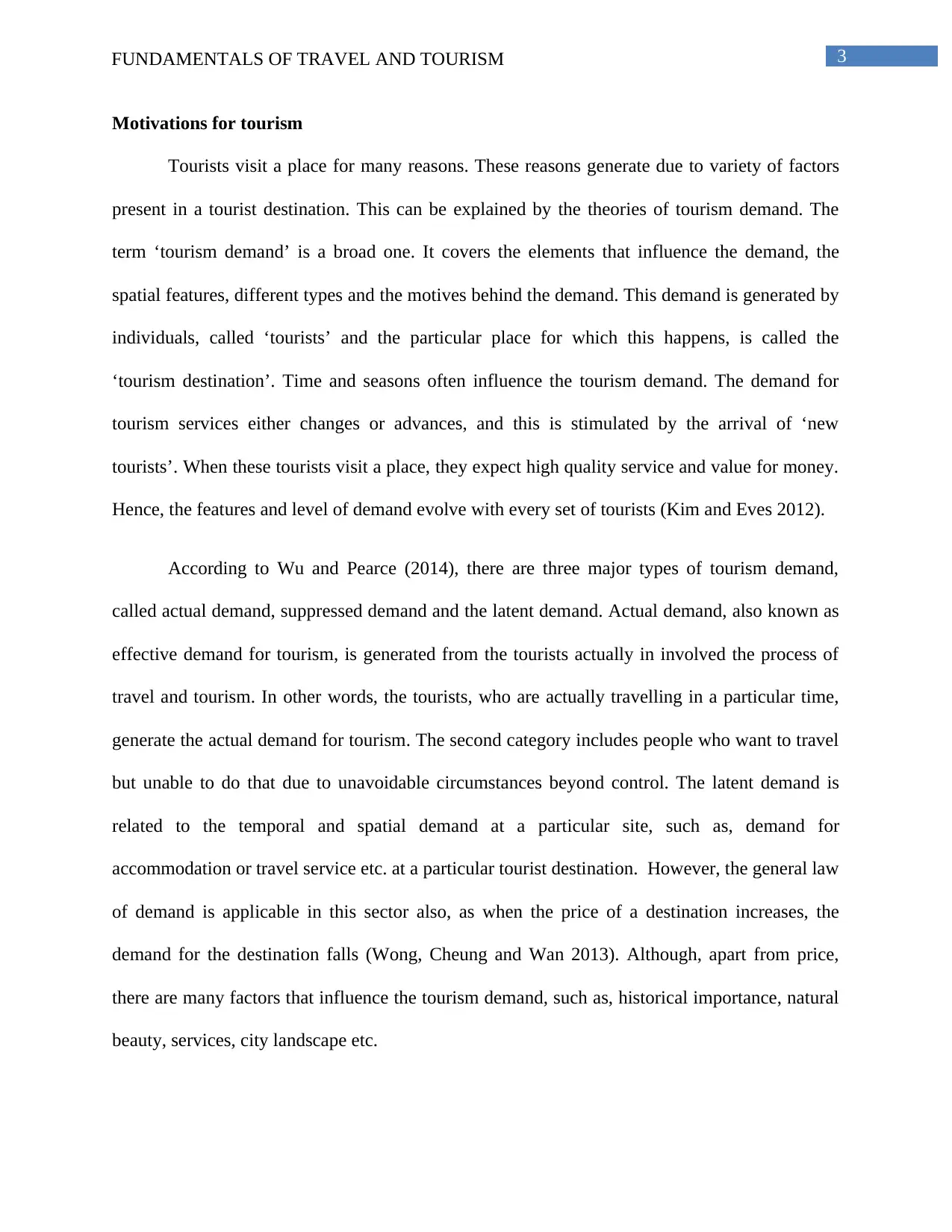
3FUNDAMENTALS OF TRAVEL AND TOURISM
Motivations for tourism
Tourists visit a place for many reasons. These reasons generate due to variety of factors
present in a tourist destination. This can be explained by the theories of tourism demand. The
term ‘tourism demand’ is a broad one. It covers the elements that influence the demand, the
spatial features, different types and the motives behind the demand. This demand is generated by
individuals, called ‘tourists’ and the particular place for which this happens, is called the
‘tourism destination’. Time and seasons often influence the tourism demand. The demand for
tourism services either changes or advances, and this is stimulated by the arrival of ‘new
tourists’. When these tourists visit a place, they expect high quality service and value for money.
Hence, the features and level of demand evolve with every set of tourists (Kim and Eves 2012).
According to Wu and Pearce (2014), there are three major types of tourism demand,
called actual demand, suppressed demand and the latent demand. Actual demand, also known as
effective demand for tourism, is generated from the tourists actually in involved the process of
travel and tourism. In other words, the tourists, who are actually travelling in a particular time,
generate the actual demand for tourism. The second category includes people who want to travel
but unable to do that due to unavoidable circumstances beyond control. The latent demand is
related to the temporal and spatial demand at a particular site, such as, demand for
accommodation or travel service etc. at a particular tourist destination. However, the general law
of demand is applicable in this sector also, as when the price of a destination increases, the
demand for the destination falls (Wong, Cheung and Wan 2013). Although, apart from price,
there are many factors that influence the tourism demand, such as, historical importance, natural
beauty, services, city landscape etc.
Motivations for tourism
Tourists visit a place for many reasons. These reasons generate due to variety of factors
present in a tourist destination. This can be explained by the theories of tourism demand. The
term ‘tourism demand’ is a broad one. It covers the elements that influence the demand, the
spatial features, different types and the motives behind the demand. This demand is generated by
individuals, called ‘tourists’ and the particular place for which this happens, is called the
‘tourism destination’. Time and seasons often influence the tourism demand. The demand for
tourism services either changes or advances, and this is stimulated by the arrival of ‘new
tourists’. When these tourists visit a place, they expect high quality service and value for money.
Hence, the features and level of demand evolve with every set of tourists (Kim and Eves 2012).
According to Wu and Pearce (2014), there are three major types of tourism demand,
called actual demand, suppressed demand and the latent demand. Actual demand, also known as
effective demand for tourism, is generated from the tourists actually in involved the process of
travel and tourism. In other words, the tourists, who are actually travelling in a particular time,
generate the actual demand for tourism. The second category includes people who want to travel
but unable to do that due to unavoidable circumstances beyond control. The latent demand is
related to the temporal and spatial demand at a particular site, such as, demand for
accommodation or travel service etc. at a particular tourist destination. However, the general law
of demand is applicable in this sector also, as when the price of a destination increases, the
demand for the destination falls (Wong, Cheung and Wan 2013). Although, apart from price,
there are many factors that influence the tourism demand, such as, historical importance, natural
beauty, services, city landscape etc.
Paraphrase This Document
Need a fresh take? Get an instant paraphrase of this document with our AI Paraphraser
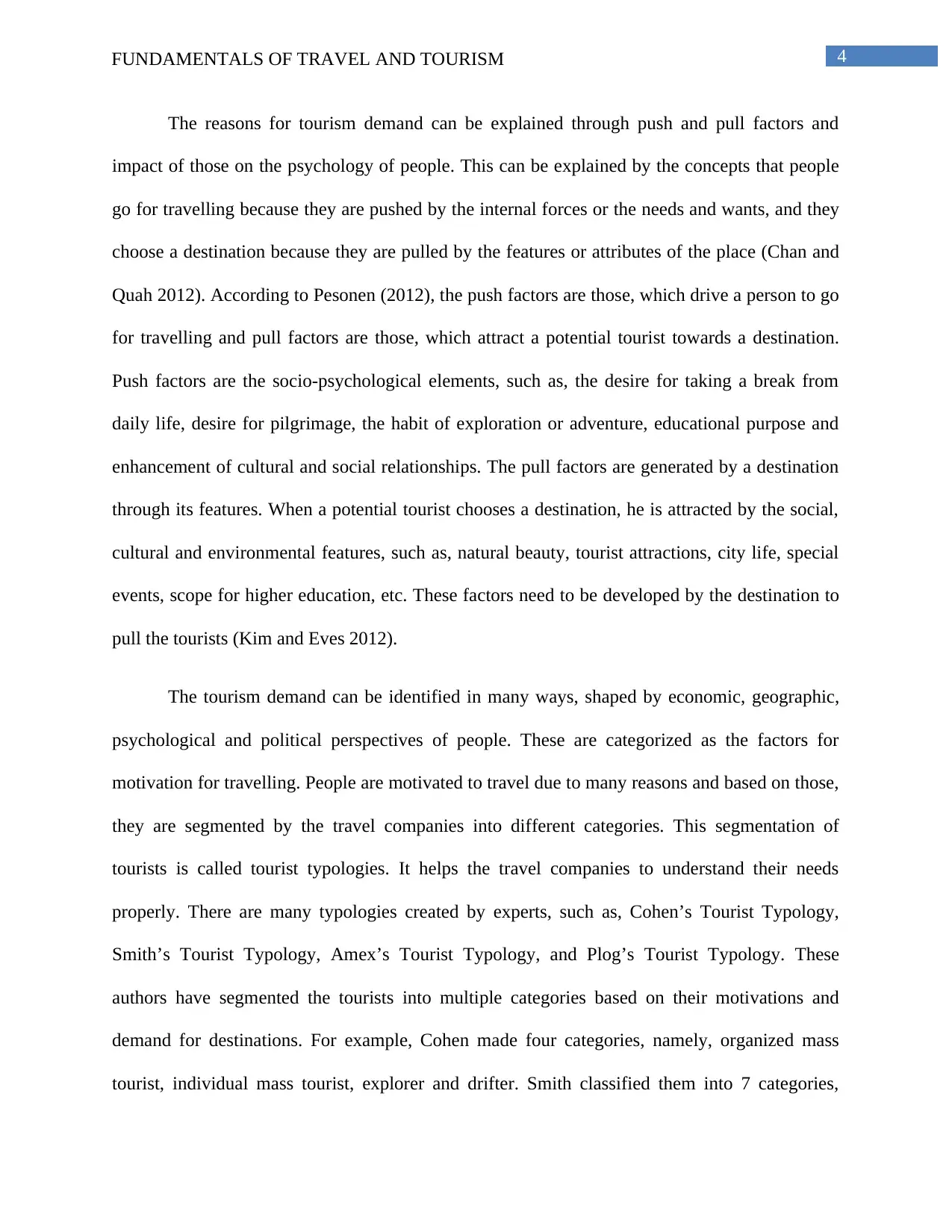
4FUNDAMENTALS OF TRAVEL AND TOURISM
The reasons for tourism demand can be explained through push and pull factors and
impact of those on the psychology of people. This can be explained by the concepts that people
go for travelling because they are pushed by the internal forces or the needs and wants, and they
choose a destination because they are pulled by the features or attributes of the place (Chan and
Quah 2012). According to Pesonen (2012), the push factors are those, which drive a person to go
for travelling and pull factors are those, which attract a potential tourist towards a destination.
Push factors are the socio-psychological elements, such as, the desire for taking a break from
daily life, desire for pilgrimage, the habit of exploration or adventure, educational purpose and
enhancement of cultural and social relationships. The pull factors are generated by a destination
through its features. When a potential tourist chooses a destination, he is attracted by the social,
cultural and environmental features, such as, natural beauty, tourist attractions, city life, special
events, scope for higher education, etc. These factors need to be developed by the destination to
pull the tourists (Kim and Eves 2012).
The tourism demand can be identified in many ways, shaped by economic, geographic,
psychological and political perspectives of people. These are categorized as the factors for
motivation for travelling. People are motivated to travel due to many reasons and based on those,
they are segmented by the travel companies into different categories. This segmentation of
tourists is called tourist typologies. It helps the travel companies to understand their needs
properly. There are many typologies created by experts, such as, Cohen’s Tourist Typology,
Smith’s Tourist Typology, Amex’s Tourist Typology, and Plog’s Tourist Typology. These
authors have segmented the tourists into multiple categories based on their motivations and
demand for destinations. For example, Cohen made four categories, namely, organized mass
tourist, individual mass tourist, explorer and drifter. Smith classified them into 7 categories,
The reasons for tourism demand can be explained through push and pull factors and
impact of those on the psychology of people. This can be explained by the concepts that people
go for travelling because they are pushed by the internal forces or the needs and wants, and they
choose a destination because they are pulled by the features or attributes of the place (Chan and
Quah 2012). According to Pesonen (2012), the push factors are those, which drive a person to go
for travelling and pull factors are those, which attract a potential tourist towards a destination.
Push factors are the socio-psychological elements, such as, the desire for taking a break from
daily life, desire for pilgrimage, the habit of exploration or adventure, educational purpose and
enhancement of cultural and social relationships. The pull factors are generated by a destination
through its features. When a potential tourist chooses a destination, he is attracted by the social,
cultural and environmental features, such as, natural beauty, tourist attractions, city life, special
events, scope for higher education, etc. These factors need to be developed by the destination to
pull the tourists (Kim and Eves 2012).
The tourism demand can be identified in many ways, shaped by economic, geographic,
psychological and political perspectives of people. These are categorized as the factors for
motivation for travelling. People are motivated to travel due to many reasons and based on those,
they are segmented by the travel companies into different categories. This segmentation of
tourists is called tourist typologies. It helps the travel companies to understand their needs
properly. There are many typologies created by experts, such as, Cohen’s Tourist Typology,
Smith’s Tourist Typology, Amex’s Tourist Typology, and Plog’s Tourist Typology. These
authors have segmented the tourists into multiple categories based on their motivations and
demand for destinations. For example, Cohen made four categories, namely, organized mass
tourist, individual mass tourist, explorer and drifter. Smith classified them into 7 categories,
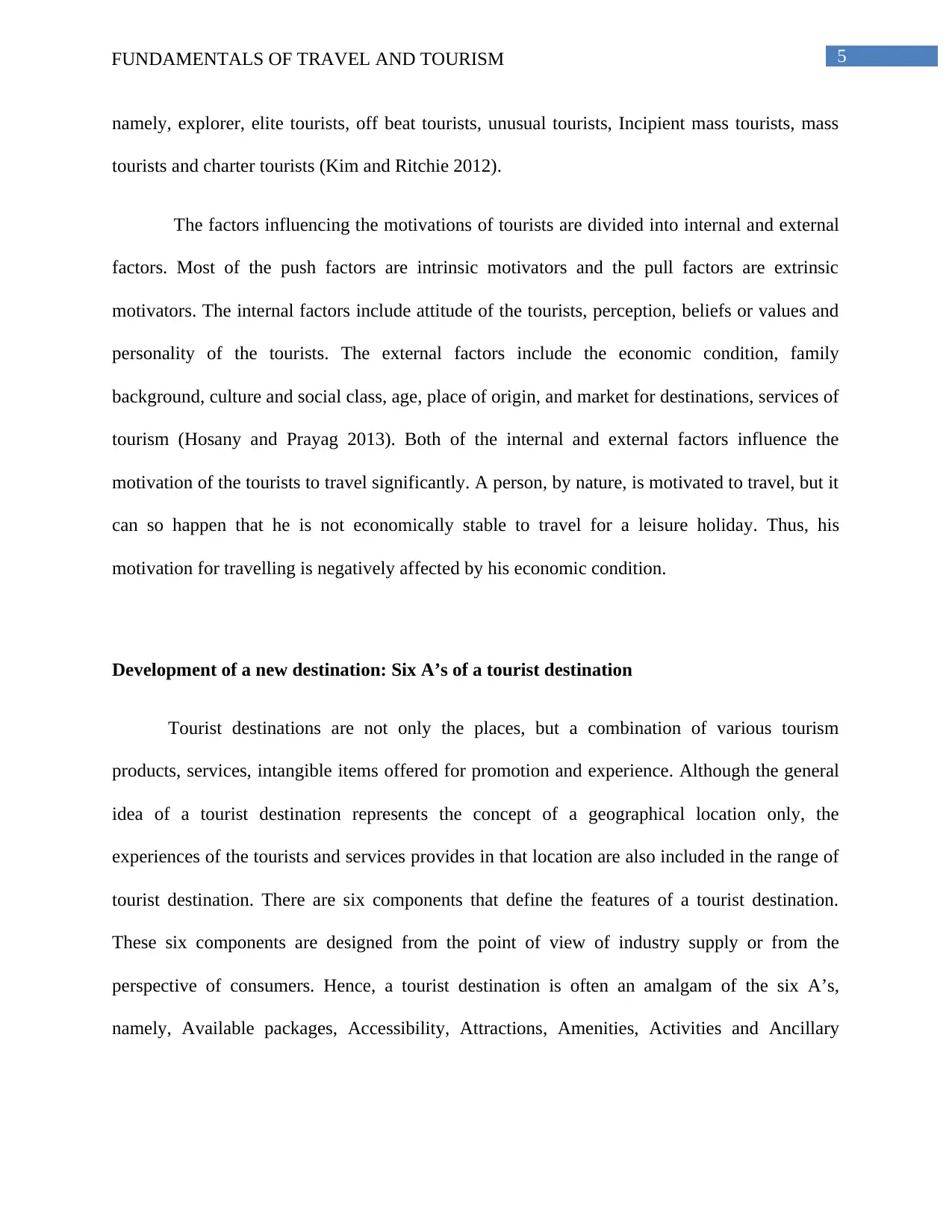
5FUNDAMENTALS OF TRAVEL AND TOURISM
namely, explorer, elite tourists, off beat tourists, unusual tourists, Incipient mass tourists, mass
tourists and charter tourists (Kim and Ritchie 2012).
The factors influencing the motivations of tourists are divided into internal and external
factors. Most of the push factors are intrinsic motivators and the pull factors are extrinsic
motivators. The internal factors include attitude of the tourists, perception, beliefs or values and
personality of the tourists. The external factors include the economic condition, family
background, culture and social class, age, place of origin, and market for destinations, services of
tourism (Hosany and Prayag 2013). Both of the internal and external factors influence the
motivation of the tourists to travel significantly. A person, by nature, is motivated to travel, but it
can so happen that he is not economically stable to travel for a leisure holiday. Thus, his
motivation for travelling is negatively affected by his economic condition.
Development of a new destination: Six A’s of a tourist destination
Tourist destinations are not only the places, but a combination of various tourism
products, services, intangible items offered for promotion and experience. Although the general
idea of a tourist destination represents the concept of a geographical location only, the
experiences of the tourists and services provides in that location are also included in the range of
tourist destination. There are six components that define the features of a tourist destination.
These six components are designed from the point of view of industry supply or from the
perspective of consumers. Hence, a tourist destination is often an amalgam of the six A’s,
namely, Available packages, Accessibility, Attractions, Amenities, Activities and Ancillary
namely, explorer, elite tourists, off beat tourists, unusual tourists, Incipient mass tourists, mass
tourists and charter tourists (Kim and Ritchie 2012).
The factors influencing the motivations of tourists are divided into internal and external
factors. Most of the push factors are intrinsic motivators and the pull factors are extrinsic
motivators. The internal factors include attitude of the tourists, perception, beliefs or values and
personality of the tourists. The external factors include the economic condition, family
background, culture and social class, age, place of origin, and market for destinations, services of
tourism (Hosany and Prayag 2013). Both of the internal and external factors influence the
motivation of the tourists to travel significantly. A person, by nature, is motivated to travel, but it
can so happen that he is not economically stable to travel for a leisure holiday. Thus, his
motivation for travelling is negatively affected by his economic condition.
Development of a new destination: Six A’s of a tourist destination
Tourist destinations are not only the places, but a combination of various tourism
products, services, intangible items offered for promotion and experience. Although the general
idea of a tourist destination represents the concept of a geographical location only, the
experiences of the tourists and services provides in that location are also included in the range of
tourist destination. There are six components that define the features of a tourist destination.
These six components are designed from the point of view of industry supply or from the
perspective of consumers. Hence, a tourist destination is often an amalgam of the six A’s,
namely, Available packages, Accessibility, Attractions, Amenities, Activities and Ancillary
⊘ This is a preview!⊘
Do you want full access?
Subscribe today to unlock all pages.

Trusted by 1+ million students worldwide
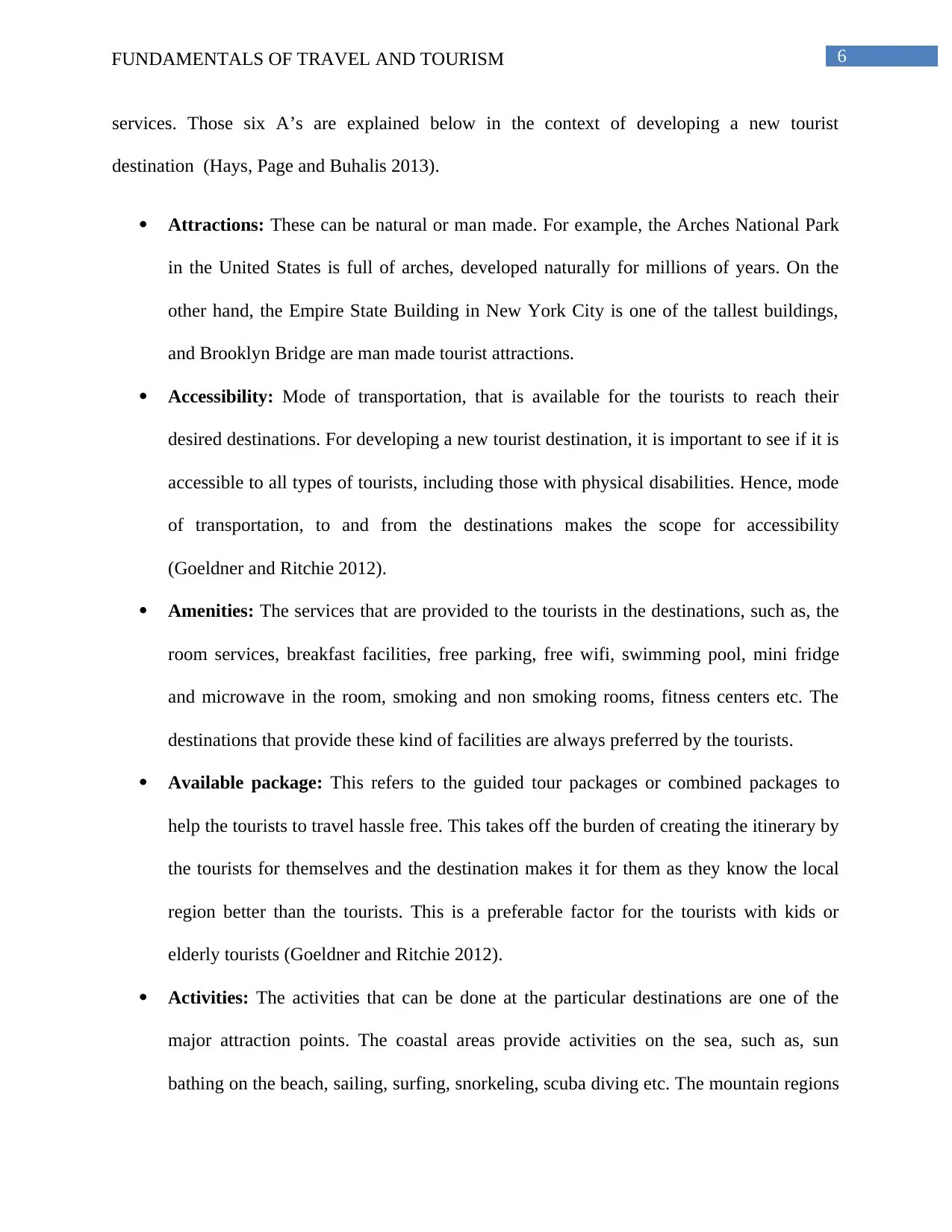
6FUNDAMENTALS OF TRAVEL AND TOURISM
services. Those six A’s are explained below in the context of developing a new tourist
destination (Hays, Page and Buhalis 2013).
Attractions: These can be natural or man made. For example, the Arches National Park
in the United States is full of arches, developed naturally for millions of years. On the
other hand, the Empire State Building in New York City is one of the tallest buildings,
and Brooklyn Bridge are man made tourist attractions.
Accessibility: Mode of transportation, that is available for the tourists to reach their
desired destinations. For developing a new tourist destination, it is important to see if it is
accessible to all types of tourists, including those with physical disabilities. Hence, mode
of transportation, to and from the destinations makes the scope for accessibility
(Goeldner and Ritchie 2012).
Amenities: The services that are provided to the tourists in the destinations, such as, the
room services, breakfast facilities, free parking, free wifi, swimming pool, mini fridge
and microwave in the room, smoking and non smoking rooms, fitness centers etc. The
destinations that provide these kind of facilities are always preferred by the tourists.
Available package: This refers to the guided tour packages or combined packages to
help the tourists to travel hassle free. This takes off the burden of creating the itinerary by
the tourists for themselves and the destination makes it for them as they know the local
region better than the tourists. This is a preferable factor for the tourists with kids or
elderly tourists (Goeldner and Ritchie 2012).
Activities: The activities that can be done at the particular destinations are one of the
major attraction points. The coastal areas provide activities on the sea, such as, sun
bathing on the beach, sailing, surfing, snorkeling, scuba diving etc. The mountain regions
services. Those six A’s are explained below in the context of developing a new tourist
destination (Hays, Page and Buhalis 2013).
Attractions: These can be natural or man made. For example, the Arches National Park
in the United States is full of arches, developed naturally for millions of years. On the
other hand, the Empire State Building in New York City is one of the tallest buildings,
and Brooklyn Bridge are man made tourist attractions.
Accessibility: Mode of transportation, that is available for the tourists to reach their
desired destinations. For developing a new tourist destination, it is important to see if it is
accessible to all types of tourists, including those with physical disabilities. Hence, mode
of transportation, to and from the destinations makes the scope for accessibility
(Goeldner and Ritchie 2012).
Amenities: The services that are provided to the tourists in the destinations, such as, the
room services, breakfast facilities, free parking, free wifi, swimming pool, mini fridge
and microwave in the room, smoking and non smoking rooms, fitness centers etc. The
destinations that provide these kind of facilities are always preferred by the tourists.
Available package: This refers to the guided tour packages or combined packages to
help the tourists to travel hassle free. This takes off the burden of creating the itinerary by
the tourists for themselves and the destination makes it for them as they know the local
region better than the tourists. This is a preferable factor for the tourists with kids or
elderly tourists (Goeldner and Ritchie 2012).
Activities: The activities that can be done at the particular destinations are one of the
major attraction points. The coastal areas provide activities on the sea, such as, sun
bathing on the beach, sailing, surfing, snorkeling, scuba diving etc. The mountain regions
Paraphrase This Document
Need a fresh take? Get an instant paraphrase of this document with our AI Paraphraser

7FUNDAMENTALS OF TRAVEL AND TOURISM
provide the scope for hiking, trekking, mountain climbing, camping into the woods etc.
The destinations with such scopes for activities are always preferred by the tourists.
Ancillary services: This refers to the development of marketing and coordinating
activities in the destinations. For example, many destinations print tourism brochures and
keep them on the front desk to help the tourists. The brochures include natural attractions,
city or town attractions, theatre activities information, restaurant guides, transport guides
etc. This is a part of marketing for the destination.
For developing a new tourist destination, it is very essential to evaluate the six A’s of the
destination. These factors cover all types of features such as, natural resources, general
infrastructure, atmosphere and tourism infrastructure. Hence, a new destination must cover all
these aspects to become a preferred one. Tourists in the modern world, have the access to the
modern technologies, and therefore, can express their choices very quickly based on the
components provided. Hence, while designing a new destination, it is important to see if there
are natural or man made attractions, if the accessibility options are well developed, if the basic
amenities are provided, if there is any available package, the number of activities available and if
there is any ancillary services. These factors influence the motivation of the tourists and these
can be categorized as pull factors of the destination (Hosany and Prayag 2013).
Public, private and voluntary organizations in Tourism supply chain in UK
Tourism supply chain refers to the network of the tourism organizations involved in
various activities that cover the supply of various elements of the tourism products or services,
such as, cars, flights, accommodation, and distribution and marketing of the end product or
service of the tourism sector at a particular tourist destination (Guo and He 2012). Thus, it
provide the scope for hiking, trekking, mountain climbing, camping into the woods etc.
The destinations with such scopes for activities are always preferred by the tourists.
Ancillary services: This refers to the development of marketing and coordinating
activities in the destinations. For example, many destinations print tourism brochures and
keep them on the front desk to help the tourists. The brochures include natural attractions,
city or town attractions, theatre activities information, restaurant guides, transport guides
etc. This is a part of marketing for the destination.
For developing a new tourist destination, it is very essential to evaluate the six A’s of the
destination. These factors cover all types of features such as, natural resources, general
infrastructure, atmosphere and tourism infrastructure. Hence, a new destination must cover all
these aspects to become a preferred one. Tourists in the modern world, have the access to the
modern technologies, and therefore, can express their choices very quickly based on the
components provided. Hence, while designing a new destination, it is important to see if there
are natural or man made attractions, if the accessibility options are well developed, if the basic
amenities are provided, if there is any available package, the number of activities available and if
there is any ancillary services. These factors influence the motivation of the tourists and these
can be categorized as pull factors of the destination (Hosany and Prayag 2013).
Public, private and voluntary organizations in Tourism supply chain in UK
Tourism supply chain refers to the network of the tourism organizations involved in
various activities that cover the supply of various elements of the tourism products or services,
such as, cars, flights, accommodation, and distribution and marketing of the end product or
service of the tourism sector at a particular tourist destination (Guo and He 2012). Thus, it
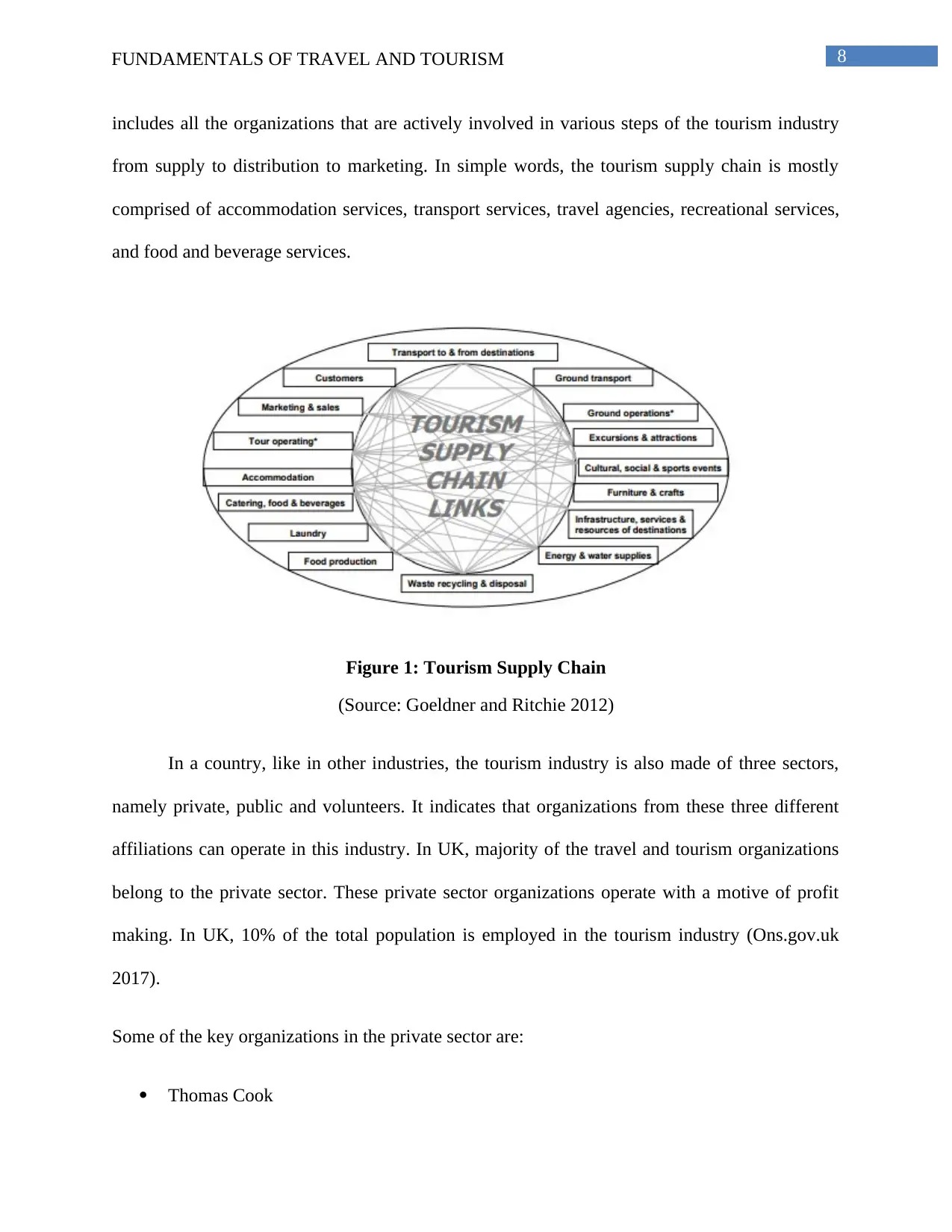
8FUNDAMENTALS OF TRAVEL AND TOURISM
includes all the organizations that are actively involved in various steps of the tourism industry
from supply to distribution to marketing. In simple words, the tourism supply chain is mostly
comprised of accommodation services, transport services, travel agencies, recreational services,
and food and beverage services.
Figure 1: Tourism Supply Chain
(Source: Goeldner and Ritchie 2012)
In a country, like in other industries, the tourism industry is also made of three sectors,
namely private, public and volunteers. It indicates that organizations from these three different
affiliations can operate in this industry. In UK, majority of the travel and tourism organizations
belong to the private sector. These private sector organizations operate with a motive of profit
making. In UK, 10% of the total population is employed in the tourism industry (Ons.gov.uk
2017).
Some of the key organizations in the private sector are:
Thomas Cook
includes all the organizations that are actively involved in various steps of the tourism industry
from supply to distribution to marketing. In simple words, the tourism supply chain is mostly
comprised of accommodation services, transport services, travel agencies, recreational services,
and food and beverage services.
Figure 1: Tourism Supply Chain
(Source: Goeldner and Ritchie 2012)
In a country, like in other industries, the tourism industry is also made of three sectors,
namely private, public and volunteers. It indicates that organizations from these three different
affiliations can operate in this industry. In UK, majority of the travel and tourism organizations
belong to the private sector. These private sector organizations operate with a motive of profit
making. In UK, 10% of the total population is employed in the tourism industry (Ons.gov.uk
2017).
Some of the key organizations in the private sector are:
Thomas Cook
⊘ This is a preview!⊘
Do you want full access?
Subscribe today to unlock all pages.

Trusted by 1+ million students worldwide
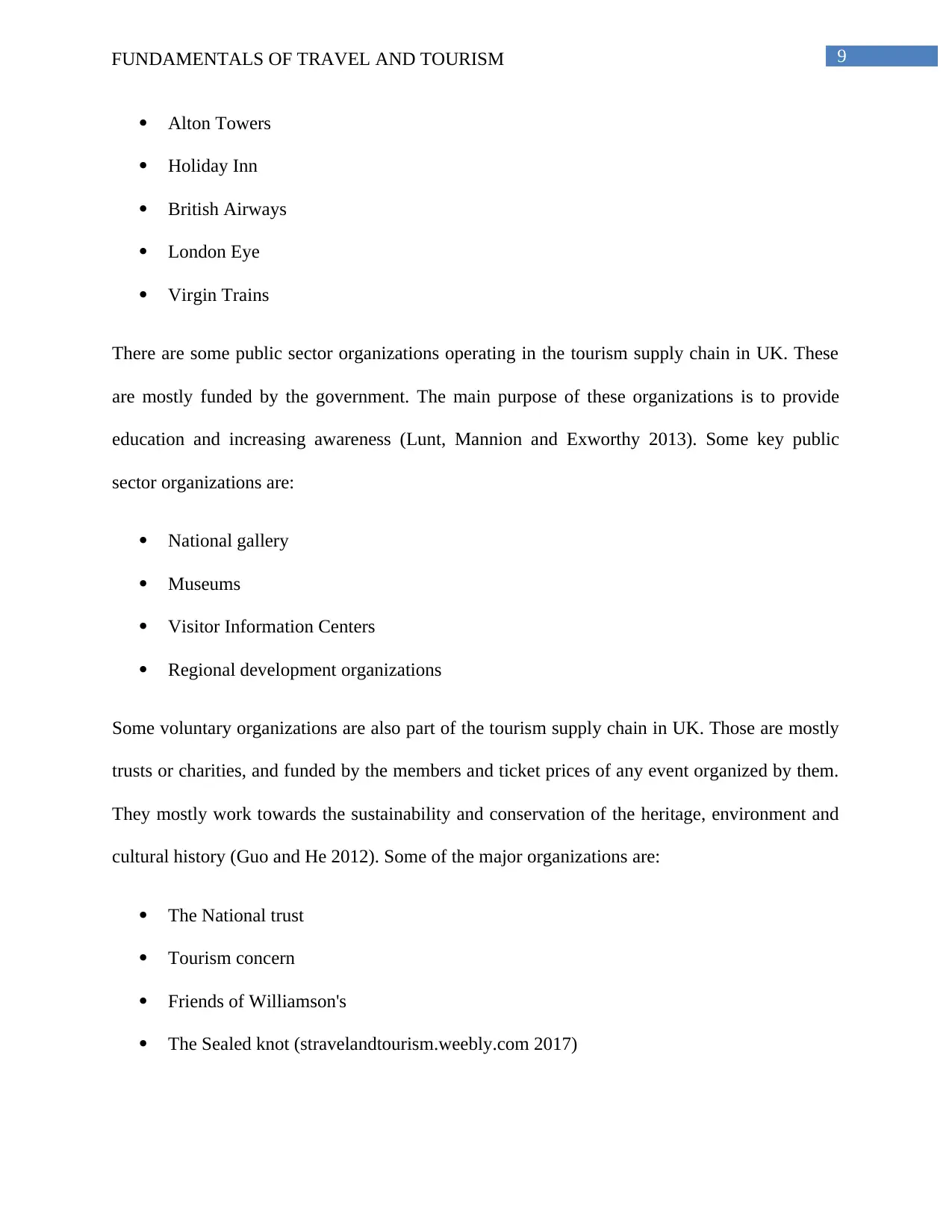
9FUNDAMENTALS OF TRAVEL AND TOURISM
Alton Towers
Holiday Inn
British Airways
London Eye
Virgin Trains
There are some public sector organizations operating in the tourism supply chain in UK. These
are mostly funded by the government. The main purpose of these organizations is to provide
education and increasing awareness (Lunt, Mannion and Exworthy 2013). Some key public
sector organizations are:
National gallery
Museums
Visitor Information Centers
Regional development organizations
Some voluntary organizations are also part of the tourism supply chain in UK. Those are mostly
trusts or charities, and funded by the members and ticket prices of any event organized by them.
They mostly work towards the sustainability and conservation of the heritage, environment and
cultural history (Guo and He 2012). Some of the major organizations are:
The National trust
Tourism concern
Friends of Williamson's
The Sealed knot (stravelandtourism.weebly.com 2017)
Alton Towers
Holiday Inn
British Airways
London Eye
Virgin Trains
There are some public sector organizations operating in the tourism supply chain in UK. These
are mostly funded by the government. The main purpose of these organizations is to provide
education and increasing awareness (Lunt, Mannion and Exworthy 2013). Some key public
sector organizations are:
National gallery
Museums
Visitor Information Centers
Regional development organizations
Some voluntary organizations are also part of the tourism supply chain in UK. Those are mostly
trusts or charities, and funded by the members and ticket prices of any event organized by them.
They mostly work towards the sustainability and conservation of the heritage, environment and
cultural history (Guo and He 2012). Some of the major organizations are:
The National trust
Tourism concern
Friends of Williamson's
The Sealed knot (stravelandtourism.weebly.com 2017)
Paraphrase This Document
Need a fresh take? Get an instant paraphrase of this document with our AI Paraphraser
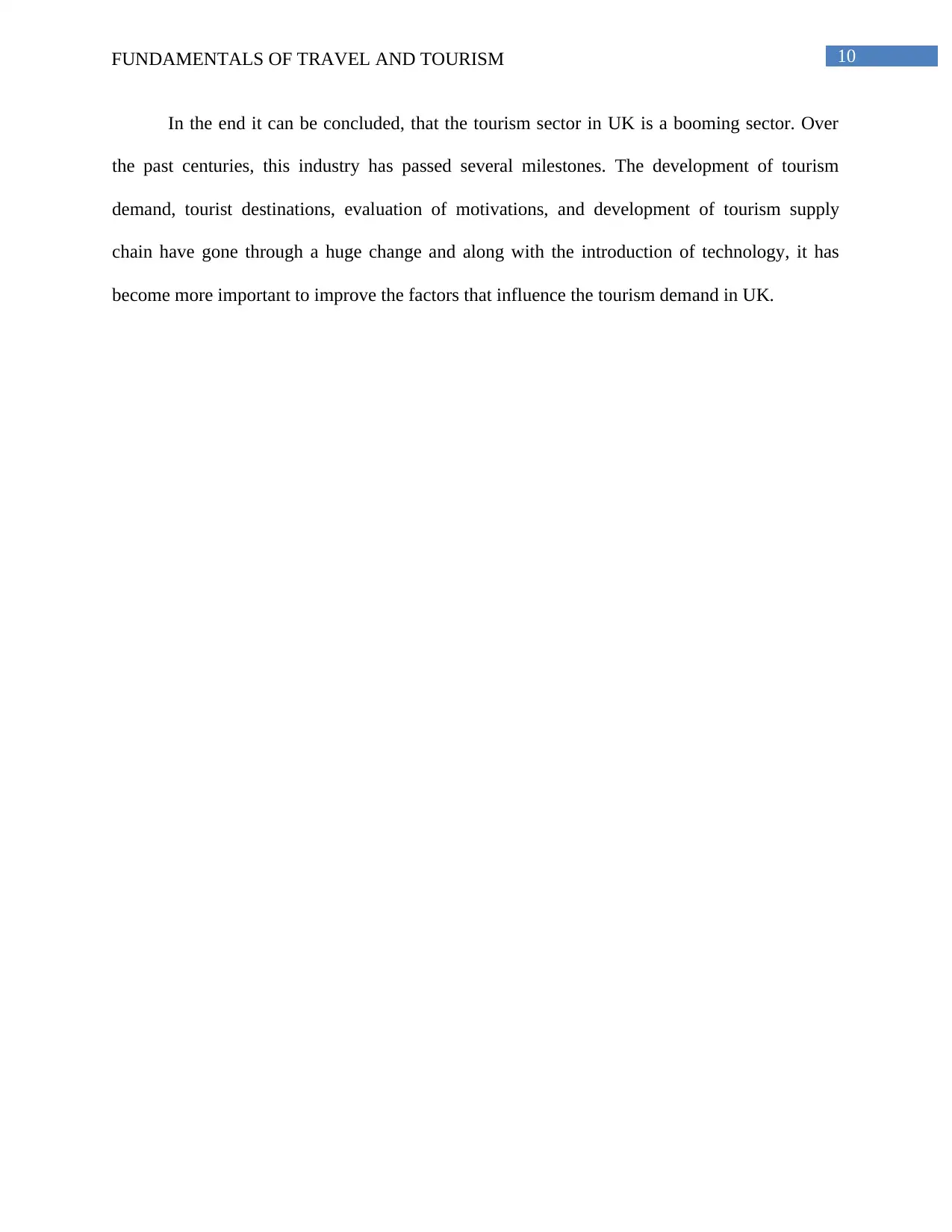
10FUNDAMENTALS OF TRAVEL AND TOURISM
In the end it can be concluded, that the tourism sector in UK is a booming sector. Over
the past centuries, this industry has passed several milestones. The development of tourism
demand, tourist destinations, evaluation of motivations, and development of tourism supply
chain have gone through a huge change and along with the introduction of technology, it has
become more important to improve the factors that influence the tourism demand in UK.
In the end it can be concluded, that the tourism sector in UK is a booming sector. Over
the past centuries, this industry has passed several milestones. The development of tourism
demand, tourist destinations, evaluation of motivations, and development of tourism supply
chain have gone through a huge change and along with the introduction of technology, it has
become more important to improve the factors that influence the tourism demand in UK.

11FUNDAMENTALS OF TRAVEL AND TOURISM
References
Ashworth, G. and Larkham, P. eds., 2013. Building a new heritage (RLE Tourism). Routledge.
Chan, J.K.L. and Quah, W.B., 2012. Start-up factors for small and medium-sized
accommodation businesses in Sabah, Malaysia: push and pull factors. Asia Pacific Journal of
Tourism Research, 17(1), pp.49-62.
Frechtling, D., 2012. Forecasting tourism demand. Routledge.
Ghimire, K.B., 2013. The native tourist: Mass tourism within developing countries. Routledge.
Goeldner, C.R. and Ritchie, J.B., 2012. Tourism: principles, practices, philosophies (No. Ed.
12). John Wiley and Sons, Inc.
Guo, X. and He, L., 2012. Tourism supply-chain coordination: The cooperation between tourism
hotel and tour operator. Tourism Economics, 18(6), pp.1361-1376.
Hall, C.M. and Page, S.J., 2014. The geography of tourism and recreation: Environment, place
and space. Routledge.
Hays, S., Page, S.J. and Buhalis, D., 2013. Social media as a destination marketing tool: its use
by national tourism organisations. Current issues in Tourism, 16(3), pp.211-239.
Horner, S. and Swarbrooke, J., 2016. Consumer behaviour in tourism. Routledge.
Hosany, S. and Prayag, G., 2013. Patterns of tourists' emotional responses, satisfaction, and
intention to recommend. Journal of Business Research, 66(6), pp.730-737.
References
Ashworth, G. and Larkham, P. eds., 2013. Building a new heritage (RLE Tourism). Routledge.
Chan, J.K.L. and Quah, W.B., 2012. Start-up factors for small and medium-sized
accommodation businesses in Sabah, Malaysia: push and pull factors. Asia Pacific Journal of
Tourism Research, 17(1), pp.49-62.
Frechtling, D., 2012. Forecasting tourism demand. Routledge.
Ghimire, K.B., 2013. The native tourist: Mass tourism within developing countries. Routledge.
Goeldner, C.R. and Ritchie, J.B., 2012. Tourism: principles, practices, philosophies (No. Ed.
12). John Wiley and Sons, Inc.
Guo, X. and He, L., 2012. Tourism supply-chain coordination: The cooperation between tourism
hotel and tour operator. Tourism Economics, 18(6), pp.1361-1376.
Hall, C.M. and Page, S.J., 2014. The geography of tourism and recreation: Environment, place
and space. Routledge.
Hays, S., Page, S.J. and Buhalis, D., 2013. Social media as a destination marketing tool: its use
by national tourism organisations. Current issues in Tourism, 16(3), pp.211-239.
Horner, S. and Swarbrooke, J., 2016. Consumer behaviour in tourism. Routledge.
Hosany, S. and Prayag, G., 2013. Patterns of tourists' emotional responses, satisfaction, and
intention to recommend. Journal of Business Research, 66(6), pp.730-737.
⊘ This is a preview!⊘
Do you want full access?
Subscribe today to unlock all pages.

Trusted by 1+ million students worldwide
1 out of 14
Related Documents
Your All-in-One AI-Powered Toolkit for Academic Success.
+13062052269
info@desklib.com
Available 24*7 on WhatsApp / Email
![[object Object]](/_next/static/media/star-bottom.7253800d.svg)
Unlock your academic potential
Copyright © 2020–2025 A2Z Services. All Rights Reserved. Developed and managed by ZUCOL.




